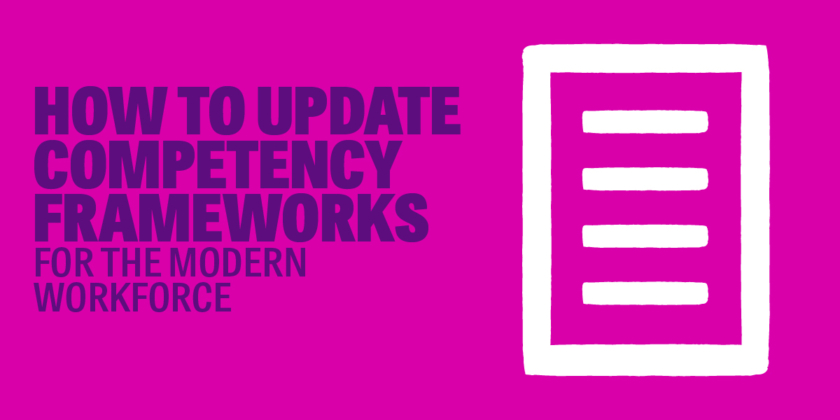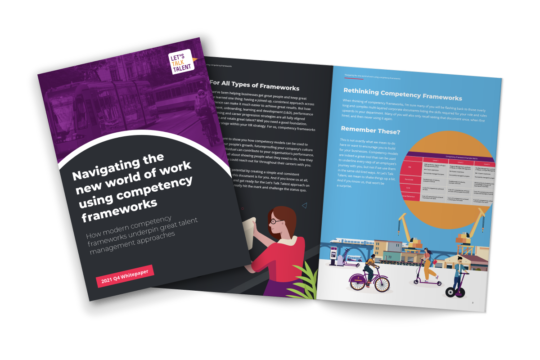How to dust off your good old competency models and turn them into an essential talent management tool
If you are part of an HR team, chances are that creating competency frameworks has been on your to-do list at some point in your career. Probably at the bottom of the list actually.
Unless it was appraisal time, you were launching a new set of company values, or you were about to start the recruitment process for a new role and needed to create a job posting. Sound familiar?
As HR professionals, we have all spent a considerable amount of time producing costly competency models, how come they so often end up on the shelf, only to be looked at once a year or so?
A Harvard Business Review article states that: ‘50% of senior leaders believe that their talent development efforts don’t adequately build critical skills and organisational capabilities’ If even managers don’t believe they have the right tools in hand to support their employees and organisations where it really matters, can competency frameworks really be considered useful? How can you make static models relevant in a world where instant feedback and agile management are becoming the norm?
It has to be said, competency frameworks do have a bad rep. Dating back from the1960s, they were initially used in organisations with a more hierarchical structure, at a time where personal development plans were based on long-term linear career trajectories. But the world of work has changed. Companies can no longer rely on recruiting lifelong employees and investing in them years in advance to take on bigger roles. And people no longer want to wait around for specific seats to become vacant.
The parent-child relationship has evolved towards an equal partnership and organisations have now understood that diverse skillsets and varied experiences are preferable to a perfectly aligned career pathway. So does this mean the end of the competency frameworks?
At Let’s Talk Talent, we think competency models do indeed have their uses. But like everything else, they have to be maintained and adapted along the way. It’s only natural for a tool that’s been around for decades to get a makeover and transition towards a more agile and fluid corporate world.
After all, you know us. We don’t like traditional box-ticking stuff. Or beige.
Creating effective competency frameworks
The purpose of tools such as competency frameworks is quite simply to manage expectations. From the attraction stage to when an employee leaves your organisation, they should be clear on the what and how of delivery in order to help the business reach its goals.
Frameworks can help managers direct their teams’ efforts, spot skills gaps and training needs and shine a spotlight on those behaviours and attributes that are not only valued, but required. And when used well, competency frameworks can help do just that.
Creating effective tools to help the leaders and managers within your business support employee performance starts with a change in perspective and requires consumerising. Yes, we made up a new word. And we’re sticking to it!
When putting together anything from recruitment to training and career development materials, it’s crucial to put a consumer lens on and view employees, current or future, as you would your main customer base. This means reviewing their whole lifecycle and ensuring anything created can support them at every milestone along the way.
Competency frameworks should be open and transparent and help employees be clear on how to be successful within your business. For most companies, this will mean three things: simplifying, adapting and maximising the use of competency models.
Going back to basics
The final outcome of a competency framework exercise should be simple. Hugely complex multi-tiered models laden with corporate jargon will not achieve this. Keep it simple and consistent throughout the whole employee journey, from job postings to training plans.
At Let’s Talk Talent, we like to use the STAR model to understand exactly the Skills, Training and Attributes expected from people in specific roles and ensure the competency frameworks we devise for various teams are clear, simple and well understood.
Adapting for your corporate reality
If you are part of a fairly traditional organisation, chances are most of the competency frameworks include the following headings: Leadership, Innovation, Communication and Teamwork. Did we get it right? Don’t get us wrong, whilst it’s great that your people indeed have reference points in terms of corporate values and behaviours, wide concepts such as these are fairly generic and a bit woolly when it comes to applying them in every day life. So when sitting down to create specific competency grids for key roles in your business, we like to ask one key question: what does it mean to work as a (blank) at (blank)?
Client Utility Warehouse is a fantastic example of creating customised competency frameworks based on their unique organisational context. When we were asked to help their People and Culture team attract and select the people who would excel, remain within the role and compliment the organisation’s culture, we started with a comprehensive research phase. This phase was aimed at understanding one thing: what does it means to be a good customer service representative at UW?
Whilst this sounds pretty simple, it did involve a lot of work. Specifically designed semi-structured interviews, focus groups, a mix of current and former job holders, stakeholders and a whole bunch of number-crunching psychological data analysis were involved. But the hard work was worth it.
The outcome defined the overall themes and competencies needed to be a high performing CS representative at Utility Warehouse, in a language that everyone could relate to. The resulting competency frameworks were used as a basis for the ongoing staff attraction, assessment and selection phases of recruitment. The output helped direct the language and content of job ads, support CV screening and allow the creation of structural interviews and assessment centres.
The People and Culture team also worked closely with us to ensure all those involved in the recruitment process were trained based on the same standards and could assess the best potential candidates objectively and more importantly, consistently.
Use your competency frameworks regularly
Competency frameworks form the basis upon which to build other talent management tools. They are an integral part of the entire employee lifecyle, from attraction to retention.
As such, they shouldn’t be viewed as a yearly appraisal marking grid, separate from other employee experience touchpoints. Instead, they should be used as a benchmark upon which to build by helping you spot and nurture the right behaviours and attributes from the outset.
Regular check-ins and transparent feedback conversations with managers will ensure your people are clear on what they have to do every single day to be successful within your company and help the organisation reach its objectives.
Don’t do beige
So like many models, grids and tools, competency frameworks can have their place in the HR talent management toolkit. But like everything else, they are not a magic wand. They require work. Work to really adapt them to your unique organisational context, and to the individuals they are going to help develop and grow.
As the main link between business strategic objectives and people’s core skills and values, they simply cannot be generic, too complex or used to put people in expected boxes. But tailored as a modern agile guideline underlining the entire employee lifecycle, they can be powerful weapons in your talent management artillery.
Related competency frameworks resources:
- Find out more about our competency frameworks consultancy [Service]
- Download our free modern competency framework whitepaper [Free Whitepaper]
- Competency framework examples: which ones should you trust? [Blog post]
- Why your competency frameworks aren’t generating high performance [Blog post]
- How to develop effective competency frameworks [Blog post]
- The EDGE feedback framework for effective development conversations [Blog post]
- How to use competency frameworks to help career development [Blog post]
- Big list of HR Definitions [Free Resource]

